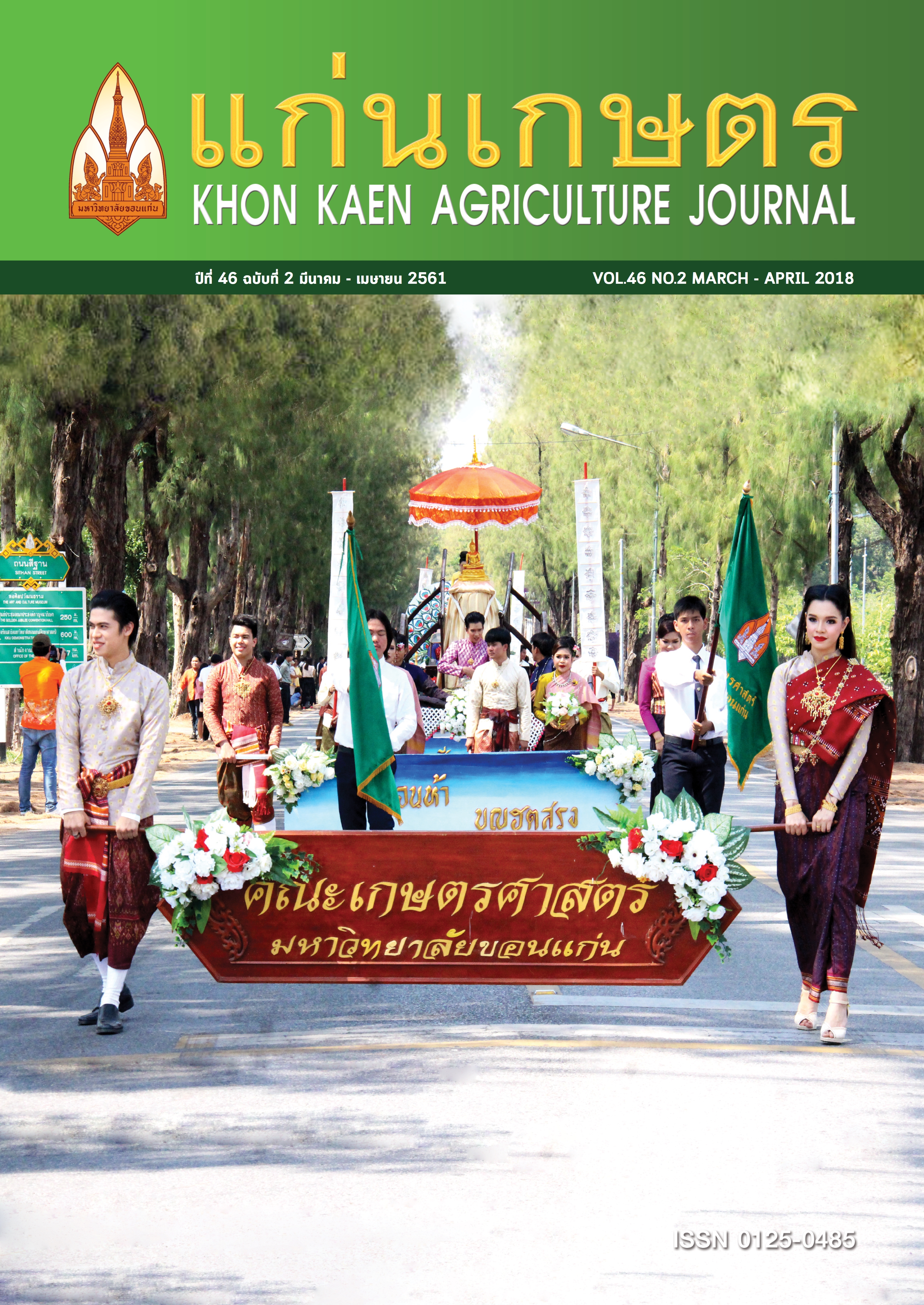พฤติกรรมการซื้อ, ผลกระทบของตราสินค้า และแฟชั่นต่อความยินดีที่จะจ่ายผลิตภัณฑ์ผ้าย้อมครามเกษตรกร ของกลุ่ม Generation B Generation X และ Generation Y
Main Article Content
บทคัดย่อ
การศึกษาครั้งนี้มีวัตถุประสงค์เปรียบเทียบพฤติกรรมการซื้อ รวมถึงผลกระทบของตราสินค้า และแฟชั่นต่อความยินดีที่จะจ่ายผลิตภัณฑ์ผ้าย้อมครามเกษตรกร ของกลุ่มเจเนเรชั่น บี เอ็กซ์ และ วาย เก็บข้อมูลจากผู้บริโภคที่เคยซื้อผ้าย้อมครามในจังหวัดสกลนคร แบ่งจำนวนตามกลุ่มของสามเจเนเรชั่น กลุ่มละ 130 ราย (รวม 390 ราย) พบว่า กลุ่มทั้งสามเจเนเรชั่นไม่สามารถรับรู้ตราสินค้าของผู้ผลิตได้ จึงไม่สามารถแยกแยะความแตกต่าง หรือตระหนักถึงตราสินค้าได้ ทั้งยังแสดงพฤติกรรมการซื้อที่ไม่แตกต่างกัน ในขณะด้านการรับรู้ตราสินค้า ความแตกต่างของตราสินค้า และปัจจัยด้านแฟชั่น มีผลกระทบทางตรงต่อความยินดีที่จะจ่ายของสามเจเนเรชั่นแตกต่างกัน นอกจากนี้การรับรู้ตราสินค้าเป็นผลปฏิสัมพันธ์ต่อความยินดีที่จ่ายผลิตภัณฑ์ผ้าย้อมคราม ในขณะที่ ปัจจัยความแตกต่างของตราสินค้า และปัจจัยด้านแฟชั่นไม่เป็นผลปฏิสัมพันธ์ต่อความยินดีที่จ่ายผลิตภัณฑ์ผ้าย้อมคราม ดังนั้น กลุ่มเกษตรกร ร้านค้าผู้จำหน่ายผ้าย้อมครามควรสร้างเอกลักษณ์ของสินค้าตนเอง เพื่อให้ผู้บริโภคสามารถแยกแยะตราสินค้าตนเองออกจากตลาดภาพรวมของผ้าย้อมครามจังหวัดสกลนคร
Article Details
เอกสารอ้างอิง
เกรียงเกณฑ์ จันทะวงศรี. 2550. ปัจจัยที่มีความสัมพันธ์กับการตัดสินใจเลือกซื้อผ้าไหมของผู้บริโภคในเขตอำเภอเมือง จังหวัดบุรีรัมย์. รายงานการศึกษาอิสระปริญญาบริหารธุรกิจมหาบัณฑิต สาขาวิชาการตลาด บัณฑิตวิทยาลัย มหาวิทยาลัยขอนแก่น.
จันทิมา พรหมเกษ. 2548. ปัจจัยที่มีผลอิทธิพลต่อพฤติกรรมในการตัดสินใจซื้อผ้าย้อมคราม กรณีศึกษา อำาเภอพรรณานิคม อำเภอภูพาน อำเภอสว่างแดนดิน อำเภออากาศอำนวย จังหวัดสกลนคร. วิทยานิพนธ์บริหารธุรกิจมหาบัณฑิต สาขาวิชาการตลาด บัณฑิตวิทยาลัย มหาวิทยาลัยขอนแก่น.
เดชา เดชะวัฒนไพศาล. 2552. การรับรู้คุณลักษณะของเจนเนอเรชั่นวายและแรงจูงใจในการทำงาน: มุมมองระหว่างเจนเนอเรชั่นต่างๆ ในองค์กร. จุฬาลงกรณ์ธุรกิจปริทัศน์. 31(121): 2-8.
เดชา เดขะวัฒนไพศาล, กฤษยา นุมพยา, จีราภา นวลลักษณ์ และชนพัฒน์ ปลื ้มบุญ. 2557. การศึกษาเจนเนอเรชั่นเอ็กซ์และเจนเนอเรชั่นวายในมุมมองต่อคุณลักษณะของตนเองและความ คาดหวังต่อคุณลักษณะของเจนเนอเรชั่นอื่น. จุฬาลงกรณ์ธุรกิจปริทัศน์. 36(141): 83-90
พรนิภา หาญมะโน. 2558. พฤติกรรมการซื้อสินค้าของกลุ่ม Generation B Generation X และ Generation Y ที่ร้านค้าปลีกสมัยใหม่ ในเขตอำเภอเมือง จังหวัดนครราชสีมา. วารสารวิชาการบริหารธุรกิจ สมาคมสถาบันอุดมศึกษาเอกชนแห่งประเทศไทย (สสอท.). 4(1): 54-75.
พิน อุ่นแก้ว. 2551. กลยุทธ์ส่วนประสมทางการตลาดของผู้ผลิตผ้าฝ้ ายย้อมครามในจังหวัดสกลนคร. วิทยานิพนธ์บริหารธุรกิจมหาบัณฑิต สาขาวิชาการตลาด บัณฑิตวิทยาลัย มหาวิทยาลัยขอนแก่น.
มานะศักดิ์ จันทะวี. 2554. การศึกษาทัศนคติของนักท่องเที่ยวที่มีต่อบรรจุภัณฑ์ ผ้าทอมือย้อมคราม อำเภออากาศอำนวย จังหวัดสกลนคร. รายงานการศึกษาอิสระปริญญาบริหารธุรกิจมหาบัณฑิต สาขาวิชาการการจัดการท่องเที่ยว บัณฑิตวิทยาลัย มหาวิทยาลัยขอนแก่น.
สำนักงานมาตรฐานผลิตภัณฑ์อุตสาหกรรม. 2559. รายชื่อผู้ที่ได้รับการรับรองคุณภาพผลิตภัณฑ์ชุมชน จังหวัดสกลนคร. กองบริหารมาตรฐานผลิตภัณฑ์ชุมชน สำนักงานมาตรฐานผลิตภัณฑ์อุตสาหกรรม. แหล่งข้อมูล: https://goo.gl/KV3XuQ. ค้นเมื่อ 14 พฤศจิกายน 2559.
อนุรัตน์ สายทอง และคณะ. 2549. การสัมมนาเทคนิคการเตรียมสีครามและการย้อมสีครามธรรมชาติ. สำนักงานพัฒนาวิทยาศาสตร์และเทคโนโลยีแห่งชาติ, กรุงเทพฯ.
Aaker, D. A. 1991. Managing Brand Equity. The United States of America. The Free America. South-Western, USA.
Bagchi, R. and A. Cheema. 2012. The Effect of Red Background Color on Willingness-to-Pay: The Moderating Role of Selling Mechanism. Journal of Consumer Research. 39(5): 947-960.
Brito, P. Q., and M. Rambocas. 2016. Assessing the impact of mystery client traits on service evaluation. Journal of Services Marketing. 30(4): 411-426.
Burnsed, K. N., and M.C. Bickle. 2015. A Comparison of U.S. Generational Cohorts’ Shopping Mall Behaviors and Desired Features. International Journal of Sales, Retailing and Marketing. 4(4): 18-30.
Choo, H. J., S.Y. Sim, H. K. Lee, and H. B. Kim. 2014. The effect of consumers’ involvement and innovativeness on the utilization of fashion wardrobe. International Journal of Consumer Studies. 38: 175–182.
Codrington, G., and S. Grant-Marshall. 2006. Mind the gap. Cape Town: Penguin, London. Cochran, W. G. 1977. Sampling Techniques. 3th Edition. John Wiley & Sons, New York.
Dobbs, L. M., L. Jensen Kimberly, M. B. Leffez, C. English Burton, M. Lambert Dayton, and D. Clark Christopher. 2016. Consumer Willingness to Pay for Tennessee Beef. Journal of Food Distribution Research. 47(2): 38-61.
Ger, G. 1999. Localizing in the Global Village: Local Firms Competing in Global Markets. California management Review. 41(4): 64–83.
Guyon, H., and J. F. Petiot. 2014. New conjoint approaches to scaling brand equity and optimising share of preference prediction. International Journal of Market Research. 57(5): 701-725.
Hair, J.F., W. C. Black, and B. J. Babin. 2010. Multivariate Data Analysis: A Global Perspective Global Edition. 7th Edition. Pearson Education
Jan-Benedict, E.M. Steen Kamp, J. Va. H. Harald, and G. Inge. 2010. What Makes Consumers Willing to Pay a Price Premium for National Brands over Private Labels?. Journal of Marketing Research. 47(6): 1011-1024.
Kansra, P. 2014. Determinants of the Buying Behavior of Young Consumers of Branded Clothes: An Empirical Analysis. The IUP Journal of Brand Management. 11(3): 57-70.
Kapferer, J.-N. 1992. Strategic Brand Management. Free Press, New York, NY and Kogan Page, London.
Ko, E., C. R. Taylor, H. Sung, J. Lee, U. Wagner, Da. C. Navarro, and F. Wang. 2012. Global marketing segmentation usefulness in the sportswear industry. Journal of Business Research. 65(11): 1565–1575.
Li Yan Ming, and L. Ellis Joan. 2014. Consumers’ willingness to pay using an experimental auction methodology: applications to brand equity. International Journal of Consumer Studies. 38: 435–440.
Marn Michael V., Eric V. Roegner, and C. C. Zawada. 2003. The Power of Pricing. McKinsey Quarterly. 1: 27–36.
Muhammada S., E. Fathelrahmanb, and R.U. TasbihUllahc. 2015. Factors Affecting Consumers’ Willingness to Pay for Certified Organic Food Products in United Arab Emirates. Journal of Food Distribution Research. 46(1): 37-45.
Napoli, A. 2014. Social media use and generational identity: Issues and consequences on peer-to-peer and cross-generational relationships – An empirical study. Participations: Journal of Audience and Reception Studies. 11(2): 182-206.
Nargundkar, R. 2008. Marketing Research: Text and Cases. 3th Edition. Tata McGraw-Hill Publishing Company Limited, New Delhi.New Strategist Press. 2013. American generations: Who they are and how they live. 8th Edition. Amityville New Strategist Press, LLC., New York.
Nunnally, J. C. 1978. Psychometric theory. 2nd Edition. McGraw-Hill, New York.Pandian, K.S.P., N.S.P. Varathani, and V. Keerthivasan. 2012. An Empirical Study on Consumer Perception Towards Branded Shirts in Trichy City. International Journal of Marketing, Financial Services & Management Research. 1(8): 18-32.
Sethuraman, R., and C. Cole. 1999. Factors Influencing the Price Premiums that Consumers Pay for National Brands over Store Brands. Journal of Product and Brand Management. 8: 340–351.
Schullery, N. M. 2013. Workplace Engagement and Generational Differences in Values. Business Communication Quarterly. 76(2): 252–265.
Wear, H., B. Heere, and A. Clopton. 2016. Are They Wearing Their Pride on Their Sleeve?. Examining the Impact of Team and University Identification upon Brand Equity. Sport Marketing Quarterly. 25(2): 79-89.
Wolf, M.M.G., S. Carpenter, and E. Qenani-Petrela. 2005. A comparison of X, Y and Boomer generation wine consumers in California. Journal of Food Distribution Research. 36(1): 186-191.
Yoo, B., N. Donthu, and S. Lee. 2000. An examination of selected marketing mix elements and brand equity. Journal of the Academy of Marketing Science. 28: 195–211.
Zhang, Y. 1996. Response to Humorous Advertising: The Moderating Effect of Need for Cognition. Journal of Adverting. 25(1): 15-32.


